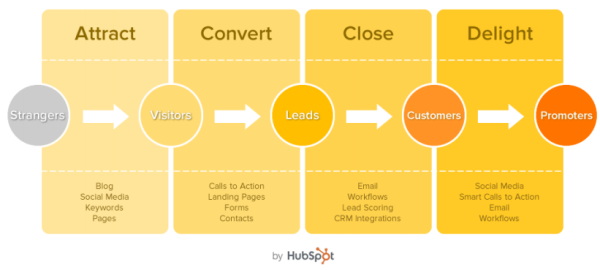 There has been a fundamental shift in the way businesses purchase goods and services. This shift in the business buying process reflects the fact that the buyer is now in control of the process. In the old buying process, the seller held all the cards. If a buyer needed accounting services, they had to meet with a sales representative to learn potential vendors' capabilties, pricing and experience. In the new business buying process, all of that information and more is available on the internet - there's no need for the buyer to take precious time to respond to unsolicited telemarketing or meet with sales reps.
There has been a fundamental shift in the way businesses purchase goods and services. This shift in the business buying process reflects the fact that the buyer is now in control of the process. In the old buying process, the seller held all the cards. If a buyer needed accounting services, they had to meet with a sales representative to learn potential vendors' capabilties, pricing and experience. In the new business buying process, all of that information and more is available on the internet - there's no need for the buyer to take precious time to respond to unsolicited telemarketing or meet with sales reps.
How has the business buying process changed?
This fundamental change is evidenced in a recent study by the Corporate Executive Board that found that 57% of the purchase decision is complete before a customer calls a supplier.
Much of the change in the business buying process is a consequence of the Great Recession. Executives increasingly rely on consensus amongst their staff on any purchase decision. While relationships will always be important in the business buying process, a solution that advances business goals trumps relationship in the new paradigm.
Yet many sales organizations have been resistant to adapting to this change. In a recent article by business author David Meerman Scott titled, "The New Rules of Sales And Service," Scott opines that, "From my perspective, sales and service is about five years behind marketing and public relations in adopting the strategies of reaching buyers directly with content."
Rather than seeking out sales reps to learn about potential solutions, buyers are accessing the information they need when they need it. Think about a recent purchase you made. If you're like me, you probably did the following:
- performed a search engine query to learn more about potential solutions
- talked to friends, colleagues and family who have solved similar problems
- read reviews and other customer experiences on social media and websites
And you probably did all of these things before thinking about undertaking the actual purchase process.
Why are sales organizations reluctant to embrace the new reality?
Change is unsettling - many people and companies resist change because they don't want to be uncomfortable. Those that recognize and embrace change are rewarded because they are living in the world of reality, not hoping that what worked 20 years ago will work today. Companies like the pioneering inbound marketing software provider HubSpot have experienced astronomic growth by embracing the change. To borrow a phrase of the day, they are "leaning into" the new business buying process and succeeding.
In the David Meerman Scott article referenced above, he states, "Even though nearly everyone turns to search engines when they research products and services and they ask their network of friends, colleagues and family members for advice, many still insist that their target market is "different". These fearful marketers who are resistant to change still invest an inordinate amount of time and money on traditional interruption advertising. They still focus on traditional pitching based media relations. They are using the old rules to try to generate attention."
Scott's analysis jibes with my experiences talking to business owners in the professional services industy - many don't believe that their buyers are using the new business buying process. Evidence shows that buyers in traditional industries like financial services and insurance are using the new business buying process. Companies like eHealthInsurance are eroding traditiional insurance agency market share by embracing the new buying paradigm.
My advice to sales leaders is to do some research - although your gut may tell you things aren't changing, rest assured - they already have.
Revenue generation strategies for the new business buying process
The overall theme of revenue generation strategies for the new business buying process is to sell the way your buyers want to buy! You need to understand who your target buyers are and how they buy. Your goal is to be transparent and provide the right information to your buyers at the right time in their buying cycle. This approach doesn't stop once you've made the sale; an effective selling approach incorporates the same tactics into service delivery.
Strategy #1: Inbound marketing
Inbound marketing is the opposite of traditional outbound marketing approaches. Rather than interrupting busy buyers with unsolicited cold calls, spammy emails and unwanted advertising, inbound marketing is a series of tactics that lets buyers find you when they look for your information about your solutions.
Here is a graphical summary of the inbound marketing process courtesy of HubSpot:

You'll note that the process doesn't stop at "Close". It aims to delight buyers with superior products and service so that they recommend the solution to their friends and colleagues. Inbound marketing is often referred to as content marketing because it aims to provide educational content to buyers so that they can conduct research on their own terms. One harsh reality of the new business buying process is that if buyers don't find you when they're conduction research, you'll never have a chance to get their business.
Strategy #2: Use transparency to qualify prospects
As a business owner, I'm besieged with cold calls. As someone with a long career as a sales rep, I have some empathy for the callers. The harsh reality is that I don't have the time to talk to people that aren't focused on what I am at that second. My empathy goes out the window when sales organizations call me repeatedly without a response. There are several phone numbers that show up on my caller ID 25 times or more. Here's a tip - if I haven't got back to you after 25 outreaches, I'm not interested! Even worse, you're getting scary - I don't do business with stalkers. The message these ninja telemarketers give me is that they're more concerned about solving their problems than even learning if I have one.
The inbound process self-qualifies your prospects. Buyers search you out when they're doing research on the solutions that you provide. Depending on the source, research shows that 75% to 90% of first-time visitors to your website aren't ready to buy. However, many end up buying from somebody.
The inbound process gives you the opportunity to start giving prospects what they need when they need it. If you do a good job educating your prospects, you'll get a chance to sell them when they progress through their buying process.
You also need to be transparent about product/service features, pricing and contractual terms on your website. It makes no sense to be coy about pricing - if someone can't afford your pricing, they're not a prospect! That doesn't mean you can't educate them with good information so that they share their good experience with their friends and colleagues.
As a sales organization, wouldn't you much rather help customers and prospects who need your solutions solve problems than buzz through the phone book hoping to find someone who is interested in your solution and is actually considering buying it?
Strategy #3: Match your outbound approach to the new buying process
Successful sales organizations direct their reps to develop relationships through referrals and introductions. Don't waste your time making 100 telemarketing calls a day. Try some of these techniques:
- Become active in trade associations and networking groups where potential buyers are. My recommendation is to focus on a few organizations and go deep - join committees and be helpful. Over time your contributions will be rewarded.
- Monitor prospects on social media channels like LinkedIn, Twitter and Facebook. See what's important to them and try to be helpful - not salesy.
- Use tools like Reachable to find pathways to get introduced to buyers by common connections. Make sure to touch base with your common connection before reaching out to the potential buyer.
- Be brief and clear about your value proposition when approaching potential buyers. They're busy and don't have time for games.
- Remember, you'll never know where that next introduction will come from. Meet people and let them know what you do, even if they're not potential buyers. Be helpful and you'll be rewarded.
Summary
Technology has changed the business buying process for good, shifting control of the process to the buyer. Embrace the change and adapt your selling process to sync to the new paradigm. It won't happen overnight, but there's no better time to start than now. How has your sales function adapted to the new paradigm?









